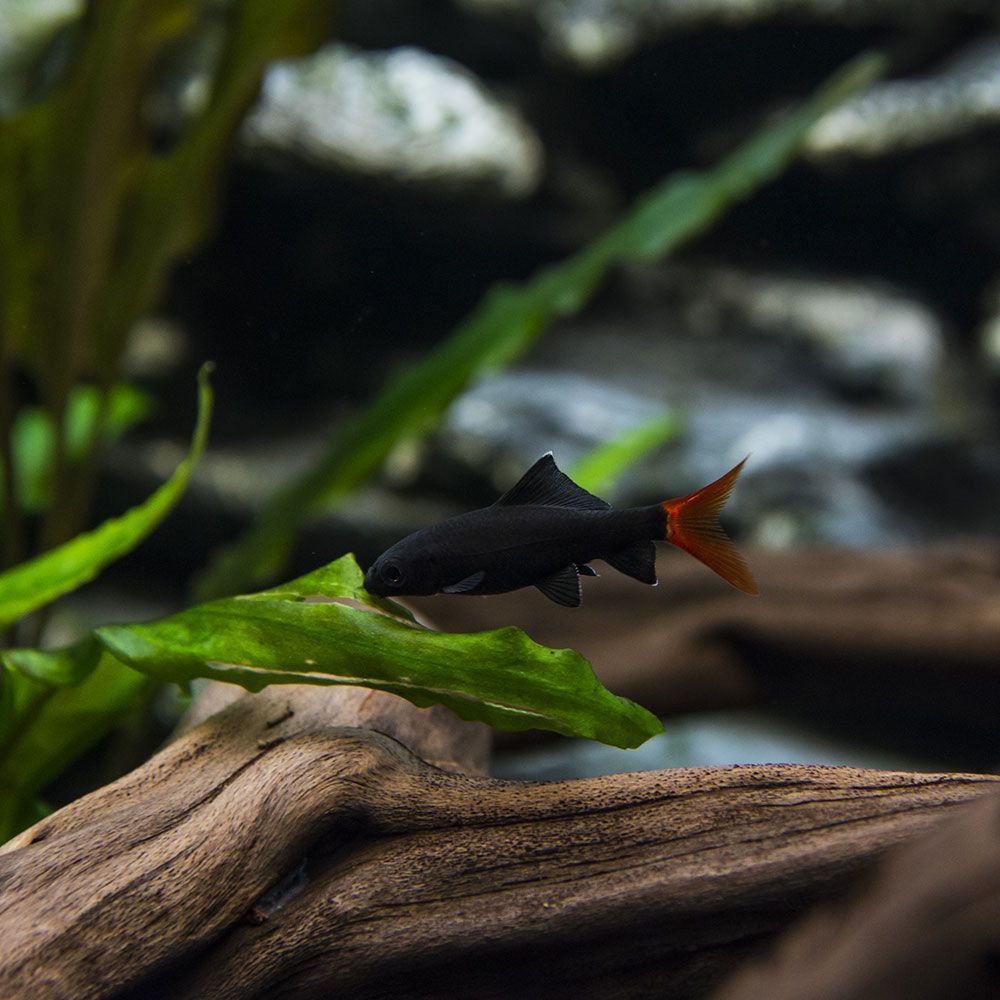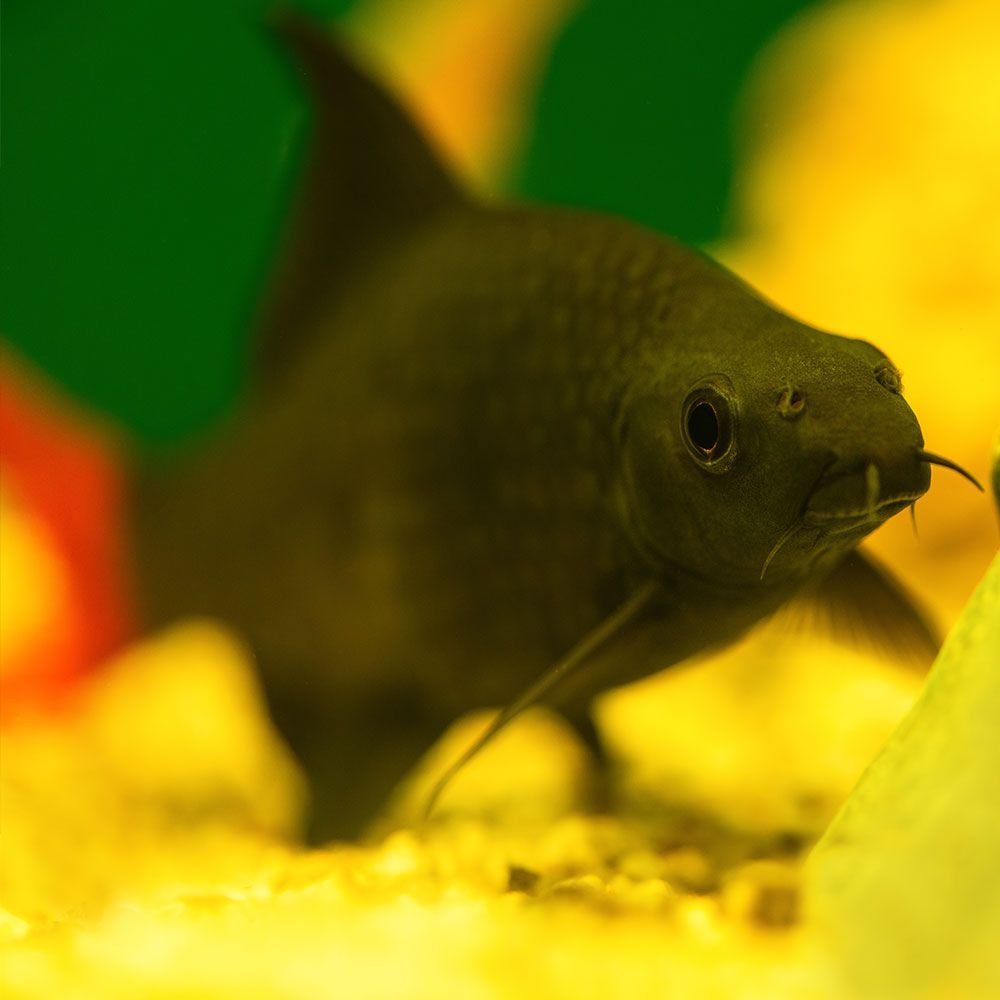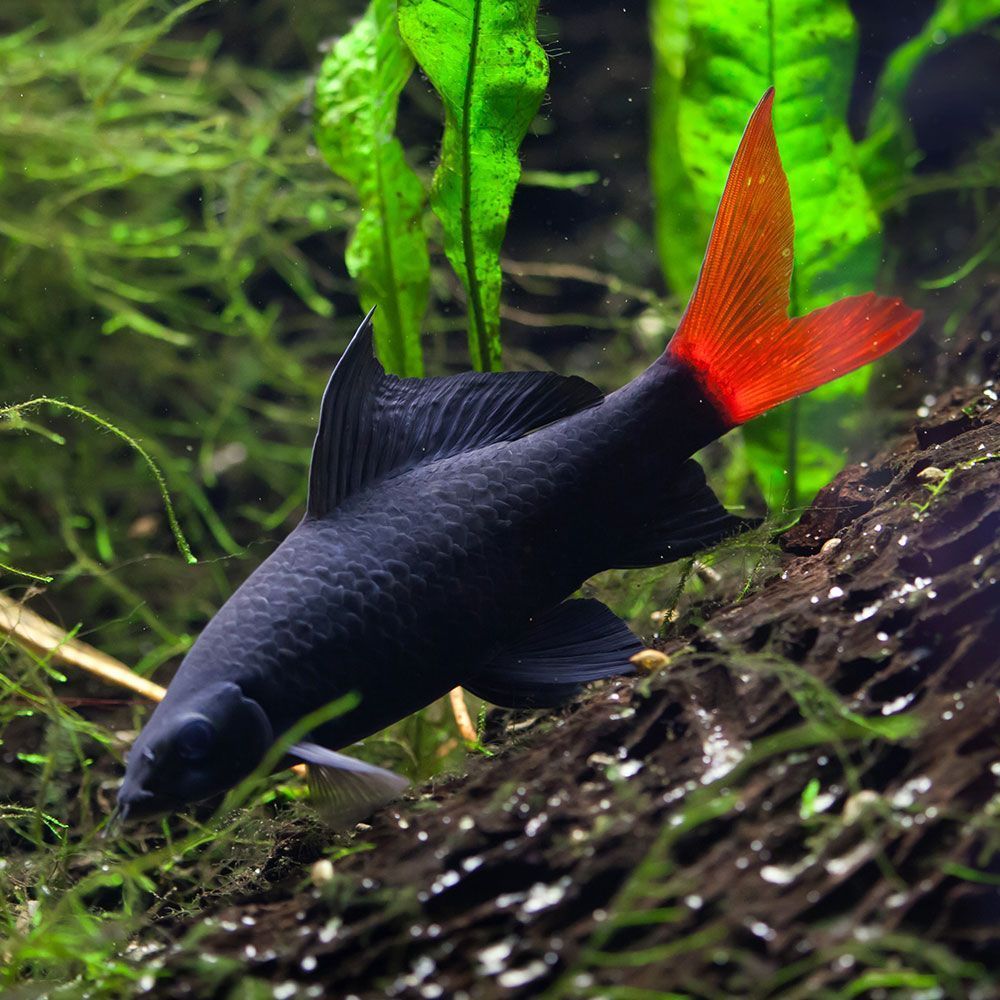A red tail shark is one of the best centerpiece fish for your freshwater tank. It is fascinating to watch it swim against strong currents in the nighttime. The best part, it has the ability to intimidate even larger species with its intriguing personality.
With a little experience in fish-keeping, it’s extremely fun to raise the fish and tame their wilful nature.
Now if you want to take on this “challenge” for your tank, let’s dive in. 😉
What is Red Tail Shark?
A red tail shark is a fish which is known for its red looking tail which stands out in its whole body and that makes it unique.
| Origin | Chao Phraya basin, Mekong basin and Thailand |
| Order | Cypriniformes |
| Family | Cyprinidae |
| Scientific Name | Epalzeorhynchos bicolor |
| Common Names | Red tail shark, Red tailed black shark, Redtail sharkminnow, Redtailed shark, Red-tailed labeo |
| IUCN Red List Status | Critically Endangered |
| Appearance | Solid black velvety streamlined, torpedo-shaped body, vibrant red caudal tail (sometimes) with a slight translucent edge, (sometimes white-tipped) triangular dorsal fin |
| Size | Up to 10-13cm (3.9-5 in) |
| Lifespan | Usually 5-8 years in captivity; Up to 15 years with the best care |
| Temperament | Moderately aggressive |
| Tank Level | Bottom and middle dwellers |
| Water Temperature | 72-79 °F (22-26 °C) |
| pH Level | 6.5-7.5 |
| Water Hardness | 8-15 dGh |
| Care Level | Medium |
| Minimum Tank Size | 55 gallons for a single fish |
| Tank Environment | Plenty of hiding spots with caves, rocks, plants, and driftwood |
| Diet | Omnivorous |
| Tank Mates | Semi-aggressive, fast swimming, or shoaling top to mid-level dwelling species |
What is the Natural Habitat of Red Tail Shark?
The red tailed shark is indigenous to the Mekong Basin and Chao Phraya Basin in Asia, primarily found in Thailand.
The fish thrives in freshwater environments, particularly in mainstream rivers, floodplains
lowland streams, and creeks with rocky or sandy substrate.
It hides under rocks and searches the substrate for biofilm, algae, crustaceans, worms, and insect larvae.
While they were once abundant, their numbers have dwindled drastically, resulting in a Critically Endangered status as per the 2011 assessment of the IUCN Red List.
Which family does Red Tail Shark?
The species is scientifically known as Epalzeorhynchos bicolor. It belongs to the Cyprinidae family within the order Cypriniformes.
It is commonly referred to as the red tailed black shark, redtail sharkminnow, red-tailed labeo, red-tail shark, and red tailed shark among aquarium enthusiasts all over the world.
Fun Fact: When stressed, the fish can turn grey to green.
How does Red Tail Shark look?

Now, if you’re interested in exploring the beauty of this fish, let’s delve into the specifics!
What is the Size of Red Tail Shark?
Red tail sharks typically reach up to 10-13cm (3.9-5 in) in size. It often leans towards the upper end of this range with proper care. The adult fish rarely grows below 5 inches.
What is the Color of Red Tail Shark?
The young red tail shark is initially dull grey with a deep orange caudal fin.
The adult fish boasts a captivating solid black velvety body that transitions into a vibrant red tail. The change from black to red is sudden and dramatic, occurring at the caudal fin’s end.
As the fish ages, its colors fade, resulting in a darker gray body with a reddish-orange tail. The caudal fin maintains a steady red color, sometimes with a slight translucent edge. Certain specimens sport a white tip on their dorsal fins.
This species does not exhibit further color variations. Any mention of an Albino red-tail shark likely refers to the albino variation of the Rainbow shark.
What are the Features of Red Tail Shark?
This fish has a classic shark-like appearance, with a streamlined, torpedo-shaped body with a distinctive triangular-shaped dorsal fin. The remaining fins are comparatively smaller, and its vibrant red tail is forked.
It also has a pointed snout with a downturned mouth with rear-facing barbels.
Like many other ray-finned fish, red tail sharks feature six distinct fins. The prominent dorsal fin slopes gracefully, and the eye-catching bright red caudal fin stands out as well.
The species also possesses sail-shaped pectoral fins on each side, accompanied by a single pelvic fin and an anal fin.
Further, it shares a resemblance with rainbow sharks. Both belong to the Cyprinidae family and feature red tails.
The primary distinction lies in their fins: rainbow sharks sport red fins, while red tail sharks possess black fins.
How is male Red Tail Shark different from a female one?
It’s challenging to distinguish male and female red tail sharks when they are young. Subtle distinctions become evident after maturing at around 15 months of age.
Male adult red tail sharks exhibit enhanced coloration, sleeker bodies, and a sharper dorsal fin compared to females.
Males also have a straighter body line around the abdomen. On the other hand, the female fish has a rounded abdomen.
How does a Red Tail Shark behave in an aquarium?
The young red tail is timid, often spending much of its time hiding. As it matures, it turns dominant, aggressive, and territorial, especially during feeding.
It can be particularly harsh toward other red tail sharks and even similar species like the redfin shark. It can lead to violent clashes, to the point of submission or even death.
Despite not being prone to nipping or causing physical harm, it persistently chases timid tank mates, which can lead to exhaustion and result in them not eating. The timid ones may suffer from malnutrition or even die.
It is also an energetic solitary swimmer that munches on algae.
What is the Lifespan of a Red Tail Shark?
The red tail shark generally has a lifespan of around 5-8 years in captivity. But in my experience, it can live up to 15 years with the best care.
Author’s Note: Pay attention to the tail color of your fish. Stress, illness, or subpar water conditions can cause them to lose their vibrancy from it.
How to take care of a Red Tail Shark?

If you’re eager to add this fish to your aquarium, let’s delve into the details of how to properly care for it!
What is the Tank Size of Red Tail Shark?
For a single red tail shark, a 55-gallon tank is recommended to accommodate their highly active swimming and reduce aggression due to territorial behavior.
What is the Water Chemistry for Red Tail Shark?
You need to maintain stable water parameters, as mentioned in the following chart, to ensure the healthy life of your red tail shark.
- pH Levels: 6.5-7.5
- Water Temperature: 72-79 °F (22-26 °C)
- Water Hardness: 8-15 dGh
- Ammonia: 0 ppm
- Nitrite: 0 ppm
- Nitrate: Below 40 ppm
Which Tank Environment is suited for Red Tail Shark?
Your next step is to ensure a secure and content environment for the fish, promoting their well-being. Here’s a guide to creating the ideal atmosphere.
Does Red Tail Shark need Substrate?
Create a natural environment with soft, fine, and dark sand. It will enhance the fish’s comfort and showcase its vibrant red tail.
Do not put fine gravel, as they might ingest it while scavenging. Refrain from using sharp or rough materials that could harm their sensitive noses and mouths, thereby reducing the risk of infection.
Which Plants does Red Tail Shark need?
The fish appreciates a tank with a lot of plants. It won’t damage live plants and grazes on algae and biofilm without harming the leaves. Plants also offer shelter for shy tank mates.
You can choose robust plants, floating plants, and plants that take up space in the tank. Some ideal ones include
- Java moss
- Java fern
- Anubias
- Vallisneria
- Elodea
- Water wisteria
- Hornwort
Which type of Lighting does Red Tail Shark need?
The red tail, being nocturnal, prefers subdued lighting and dim conditions. Avoid using harsh lighting and direct sunlight. Ensure adequate lighting to support the growth of beneficial algae.
Use lights with day/night settings that emit blue light during nighttime. This will provide the best opportunity to observe your red tail shark at its most active state.
What is the Décor for Red Tail Shark?
Like its natural habitat, include vegetation, wood, and rocks in the tank to reduce their aggressive tendencies and offer familiar enrichment.
Put in a lot of fine-leaved plants, caves, rocks, and driftwood to provide hiding spots and territory for these fish.
Place the decor so that there’s enough open space for swimming. Break their line of sight with decor to prevent chasing behaviors towards other fish.
What is the Filtration system for Red Tail Shark?
Filtration options for these species include high-flow setups like canister or hang-on-the-back filters, as well as low-flow options like sponge filters.
What is the Water Flow Rate for Red Tail Shark?
Create a moderate to high water flow in the tank to mimic their natural habitat. The fish is accustomed to swift currents and enjoys swimming against them to expend energy.
Fish Care Tip: Red tail sharks are prone to jumping. To prevent fatal escapes, ensure your tank has a secure, weighted lid.
What does Red Tail Shark eat?
Red tail shark is omnivorous and enjoys scavenging for food. In its natural habitat, it enjoys plant matter, worms, insects, and crustaceans.
It is a voracious eater who thrives on a diverse and balanced diet. So, follow this diet routine to keep your pet fish healthy:
- Sinking algae wafers
- Bloodworms
- Tubifex
- Zucchini
- Cucumber
- Zooplankton
- Sinking fish pellets
- Daphnia
- Fish flakes
- Water fleas
- Adult and larval brine shrimp
- Small worms
- Insect larvae
- Peas
- Green vegetables
- Krill (frozen, chopped up)
Remember, feed only what your pet can consume in a couple of minutes. Maintain a consistent feeding schedule for your fish. Feed it every two days, preferably during their active dusk-to-dawn period.
What are the Tank Mates for Red Tail Shark?
To ensure a harmonious environment in your tank, pick tank mates that
- Mind their own business
- Spend more time in the top water column of the aquarium.
- Semi-aggressive
- Fast-moving
Some great choices are:
- Tiger barbs
- Tinfoil barbs
- Rosy barbs
- African cichlids
- Clown loaches
- Neon tetras
- Glow light tetras
- Blue gouramis
- Paradise gouramis
- Bala sharks
- Honey gouramis
- Sparkling gouramis
- Congo tetras
- Giant danios
- Pearl gouramis
- Dwarf gouramis
- Zebra danios
- Silver dollars
- Platy fish
- Scissortail rasboras
- Freshwater flounders
- Rasboras
- Small cyprinids
- White cloud mountain minnows
- Black mollies
When introducing potential tank mates, monitor their interactions closely. Ensure that the red tail shark’s territorial behaviors don’t stress the other species.
Which Tank Mates to Avoid for Red Tail Shark?
The following tank mates should be avoided when keeping red tail sharks:
- Aggressive species: They can engage in territorial disputes and aggression, leading to stress and potential harm to both species.
- Timid bottom feeders: These fish may compete with timid bottom feeders over territory and feeding, causing conflicts and stress for both species.
- Curious species: Fish that are overly curious may wander into their territory, leading to territorial disputes and potential harm.
- Fish with similar appearance (e.g., rainbow shark): Fish with similar red coloration might trigger territorial and aggressive behavior in them, leading to conflicts.
- Slow-moving and long-finned fish (e.g., freshwater angelfish): These fish tend to bully slow-moving and long-finned fish, which can result in stress, fin nipping, and harm to the targeted fish.
- Small fish (e.g., fancy guppies, bettas): Small fish may become targets for aggression and bullying, potentially causing harm or even death.
- Invertebrates: Avoid adding invertebrates to the tank as they are likely to eat them, eliminating them from the ecosystem.
- Slow-moving bottom dwellers: They must be avoided to prevent conflicts and territorial disputes with the species.
Note: Due to territorial behavior, the cohabitation of multiple red-tail sharks in the same tank is risky. But you can keep 5 juvenile fish together in a large tank with proper spacing to prevent aggression.
What are the Common Diseases in Red Tail Shark?
Red tail sharks are hardy and adapt to gradual parameter changes, but abrupt temperature shifts can affect them. Prepare to handle the following diseases as unforeseen issues may arise.
| Disease Name | Causes | Symptoms | Treatment |
|---|---|---|---|
| Ich | External protozoan parasite | White spots on the body, loss of appetite, flashing | Quarantine diseased fish, gradually increase water temperature, treat with medication |
| Ammonia Poisoning | Ammonia buildup due to poor nitrogen cycle | Difficulty breathing, reddened gills, gasping at the water’s surface | Reduce fish population, regular water changes, partial water changes |
| Dropsy | Dirty water, stress, infection | Bloated stomach, lethargy | Frequent water changes, nutritious food, and proper medication |
| Bacterial Infections Like Aeromonas and Pseudomonas | Poor water quality | Cloudy eyes, scratching, mucous discharge, and skin lesions | Early detection, quarantine of new fish, regular water changes, specific medications |
| Fin Rot | Bacterial infection | Sluggishness, diminished appetite, tattered and frayed fins, coloration loss, inflammation at fin base | Improve water quality, eliminate potential hazards, administer antibiotics |
| Parasitic Infections | Parasitic organisms | Cloudy eyes, scratching, mucous discharge, skin lesions | Quarantine, water changes, enhancement of water conditions |
| Streptococcus iniae | Bacterial infection | Poor balance, uncoordinated swimming, erratic behavior, lethargy | Antibiotic medication, maintain clean tank conditions |
| Columnaris | Bacterial infection | Lack of energy, reduced appetite, pale white or gray spots, fin damage | Improve water quality, antibacterial treatment, and reduced stress |
Quick Tip: Always test your tank water twice weekly to keep it clean. Replace 20-30% of the water volume monthly for optimal tank conditions and disease prevention.
How to Breed Red Tail Shark in an Aquarium?
Breeding red tail sharks in captivity can be challenging due to their territorial nature and specific breeding requirements. The fish is mostly bred in fish farms.
A major challenge is the male’s intolerance of female fish in his territory for extended periods, even for mating purposes.
Here, if you’re passionate, here’s a guide on how you can do it in captivity. But don’t proceed if you’re not an expert or don’t have expert guidance:
1. Tank Conditions, Male-to-Female Ratio & Fish Conditioning
Use a breeding tank of 90 gallons with 1 male and 1 female red tail shark. Maintain the following parameters:
- Water Temperature: 75-81 °F (24-27 °C)
- pH Levels: 6.5-7
Decorate it with proper vegetation, powerful filtration, and sieved lighting for successful breeding. Provide a high-protein diet to enhance reproductive success.
2. Mating Conditions & Ritual
The male initiates courtship by swimming in figure eight and enticing the female. Once receptive, the female turns on her side to allow mating. Copulation is usually quick and rarely visible.
3. Signs of Pregnancy & Egg Release
A pregnant red tail shark female exhibits a rounder abdomen. She might carry up to 40 eggs at a time. She lays eggs daily for about a week on rocks or in caves while the male immediately fertilizes them. It can carry as many as 1000 eggs over the entire span of time.
The eggs are then incubated for approximately 36 hours before hatching. The male guards the eggs by chasing away intruders.
4. Egg Characteristics & Hatching
The eggs are relatively small in size and have pale coloration. It’s crucial to transfer them to an unfiltered hatching tank to protect them. Hatchlings feed from their egg sacs for up to four days.
5. Fry Care, Development & Juvenile Growth
After four days, the fry become free swimmers. Then, feed them newly hatched brine shrimp, infusoria, larval prey, or crushed flake food. Make sure you only opt for high-quality food and feed them several times daily.
The fry initially displays a silver to silvery brown coloration for the first few weeks. They transition to their distinctive black and fiery red hues around ten weeks of age.
After around 2 months, they can be placed in their own setup for further growth.
Breeding Tip: Place a thin layer of aquarium glass marbles or gravel at the bottom of the breeding tank. This facilitates the egg-scattering behavior of the female, allowing the male to fertilize them more effectively.
How to Buy a Red Tail Shark?
- Choose a red tail shark with vibrant coloration, active swimming, normal breathing, and well-maintained fins and body. Make sure no visible bones are sticking out, especially in younger fish, and check for clear, bright eyes without any parasites.
- Be cautious of indicators of stress or illness, including pale or dull colors, body discoloration, and thin body condition.
- Take a look at the condition of the tank where the fish are kept. Check for any dead fish floating around, observe the water clarity, and see if any fish appears unwell.
If you notice any of these signs, you might want to reconsider purchasing fish from that location.
A word from FishInAquarium
The fascinating red tail shark in your aquarium offers a unique and captivating aquatic experience. Not only do they have an alluring, vibrant appearance, but they can also accompany you late at night with their curious nature and endless activities!
If you found this article insightful, informative, and enjoyable, we encourage you to share it with fellow aquarium enthusiasts.
Drop us a mail if you have any questions, and our team will happily assist you!


